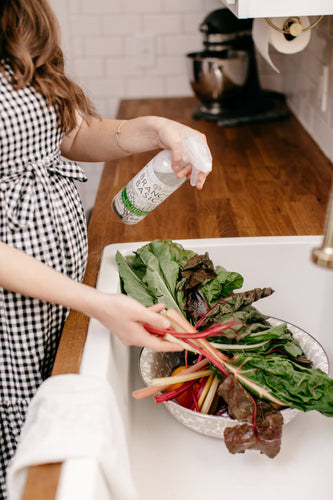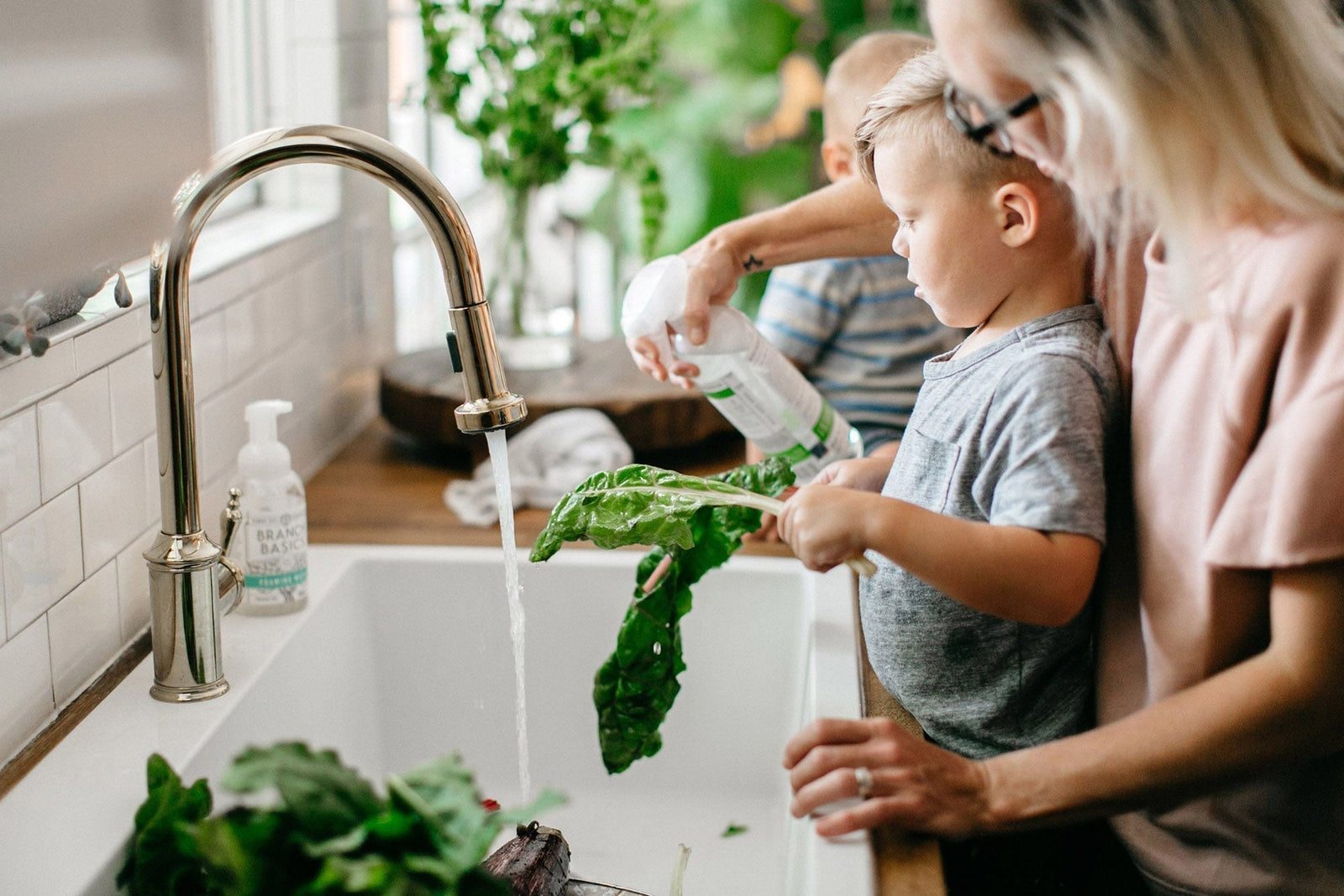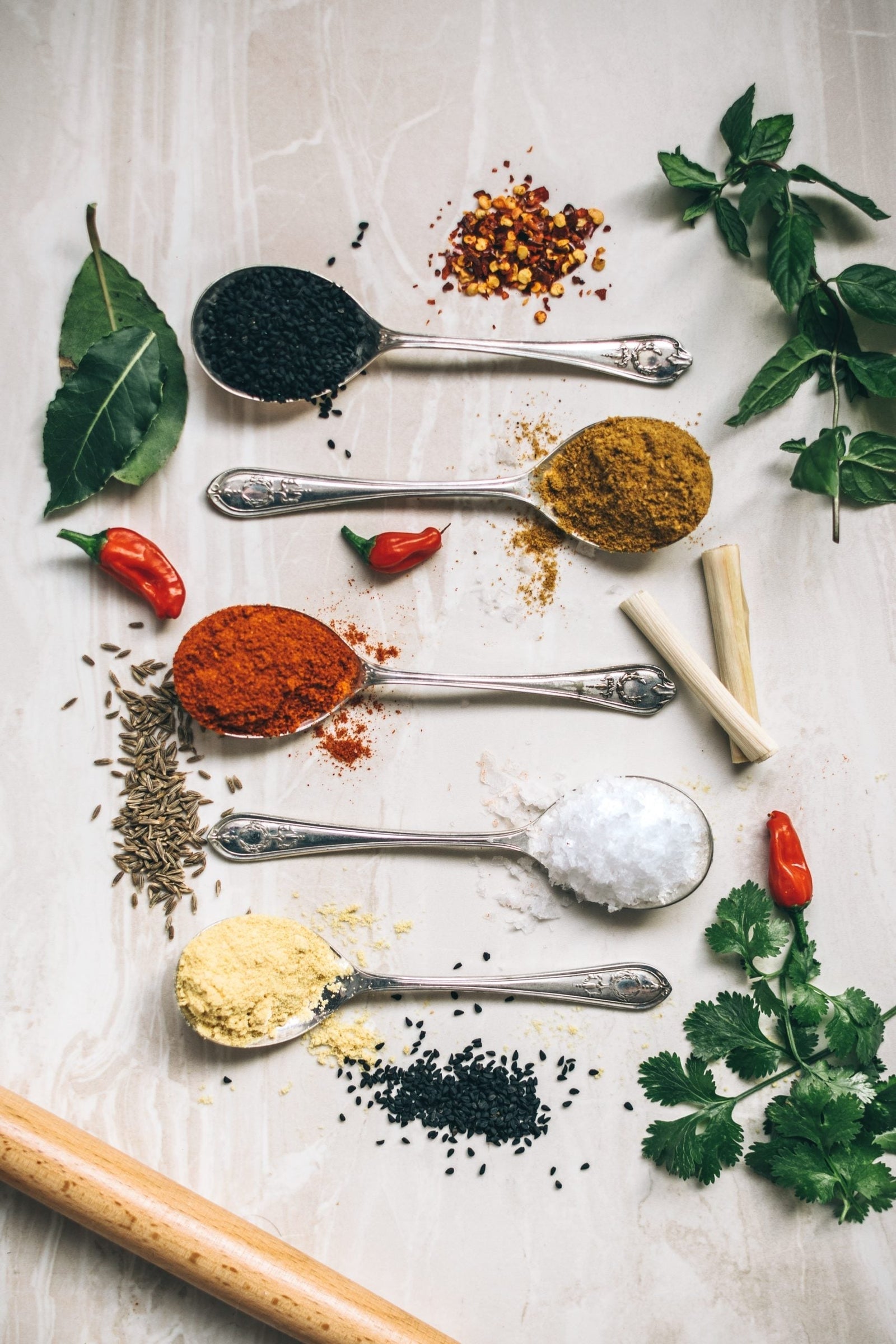How to Naturally Clean Fruits and Vegetables

Have you noticed a sharp increase in food safety recalls this year? Over 1,900 recalls were issued in 2024, the highest number since the pandemic.
This brings up an important point about the modern necessity of cleaning fruits and veggies, especially those to be eaten raw.
Below, you’ll learn why it’s so important to clean your fruits and veggies (beyond just bacteria), discover our top three, safe DIY and pre-made fruit and veggie washes and disinfectants, and how to best naturally wash different types of produce.
Why Wash Your Produce?
A few years back, reports came out questioning the effectiveness of DIY and pre-made fruit and vegetable washes. The recommendation was to use water and friction instead for the best results.
Here’s the thing: water and friction work GREAT for removing many pesticide residues, dirt, and some bacteria from hardy fruits and vegetables, and is an appropriate cleaning method for produce that will be cooked.
But, rinsing with water won’t remove all harmful bacteria2, especially on delicate produce like leafy greens or berries, which won’t hold up to scrubbing (and it doesn’t take much harmful bacteria to make you sick). Thus, taking a little extra time to use an effective fruit and veggie wash can indeed make a big difference.
Beyond bacteria, here are three more reasons to take fruit and veggie washing seriously:
Reason #1: To remove as much dirt, sand, and soil as possible
Yes, some dirt is good for building immunity, but unless you know all about the dirt your produce has been grown in, it’s best to remove it entirely. For the best results, wash your produce in cold water.
Reason #2: To remove external pesticide residues
Conventionally-grown produce, especially those listed on the Environmental Working Group’s “Dirty Dozen” list, has been shown in random testing to contain unacceptable levels of pesticide residues[1]. Long-term exposure to pesticides has been linked to cancer, damage to the nervous and reproductive systems, birth defects, and severe disruption of the immune system and GI tract32].
The effects are even more pronounced in children, and evidence suggests parental pesticide exposure can affect future generations4.
Notice we said “to remove external pesticide residues”. Unfortunately, no amount of vegetable cleaner can remove pesticides that have entered a plant via the roots or seeds; which is why we recommend buying organic or certified naturally-grown produce whenever possible.
If this isn’t an option, avoid the Dirty Dozen in favor of the Clean Fifteen and wash everything according to our instructions below (organic or not).
Reason #3: To remove external chemical residues
Does your local grocery store have a mister that sprays the produce to keep it hydrated? Verify whether or not the mist contains only water and no antimicrobial chemicals. If the water is treated, then even your organic produce may be covered in chemicals.
Reason #4: Removal of germs and parasites
According to the Food and Agricultural Organization of the United Nations’ “Parasites and Foodborne Illness”, produce is a hotbed for parasites such as tapeworm, protozoans, and small intestinal roundworms.
Think this isn’t a problem for North Americans? Sadly, it is.
Due to our consumption of imported produce and parasitic issues in our soil, fertilizer, and water supplies, the CDC estimates millions of Americans are infected with food-borne parasites every year6. Thus, thorough cleansing of produce to be eaten raw is essential, even for those fruits and vegetables with thick skin. The recent avocado scare taught us about this, as knives will carry germs or parasites from the avocado skin to the flesh. The same goes for melons, citrus fruit, winter squashes, or any thick-skinned fruit or vegetable.
The Best Ways To Wash Produce
Depending on the type of fruit or vegetable, organic or non-organic, eaten raw or cooked, you will either want to wash or soak them. This will help remove dirt, germs, parasites, pesticide and chemical residues. Note: Cleaning produce with a conventional cleaner is not recommended. A human safe surfactant cleaner like Branch Basics can be used to remove dirt, germs, parasites, pesticides and chemical residues that water may have missed. Vet ingredients for other safe cleaning options using our Tools to Become Your Own Product Advocate.
Fruit and Vegetable Washing Instructions
-
For non-organic OR organic produce with firm skins, such as avocados, melons, citrus fruits, squashes, zucchini, cucumbers, apples, etc., to be consumed raw:
- Rinse produce to remove dirt.
- Spray skin directly with All-Purpose or foam with Foaming Wash, and lightly scrub,
- Rinse with cold water to remove pesticide or chemical residues.
- Wash your knife before cutting into the produce
-
For organic varieties intended for cooking:
- Lightly scrub clean and rinse with water. With organic produce, this may be all you need. Caveat - If there are concerns about chemical residues on the surface, spray skin directly with All-Purpose or foam with Foaming Wash, lightly scrub, then rinse with cold water.
- Lightly scrub clean and rinse with water. With organic produce, this may be all you need. Caveat - If there are concerns about chemical residues on the surface, spray skin directly with All-Purpose or foam with Foaming Wash, lightly scrub, then rinse with cold water.
-
For non-organic OR organic produce like leafy greens and delicate fruits and vegetables to be raw or cooked
- Rinse dirt off the individual leaves of leafy green vegetables and gently rinse delicate fruits.
- Spray the leaves or fruit with All Purpose
- Rinse gently
Soaking Instructions:
-
For fruits and vegetables with firm skin like apples and cucumbers that you don't intend to cook.
- Option 1 - to remove germs, dirt, pesticide, and chemical residues
- Rinse produce to remove dirt.
- Soak firm skinned fruits and vegetables in a clean sink or bowl with water and 1/4-1/2 teaspoon Concentrate
- Agitate the water
- Remove the produce after a couple of minutes and rinse.
- Rinse produce to remove dirt.
- Option 2 - Some people may want to take an extra step. The options above remove germs, but if you want to double down on parasites, viruses and bacteria including e coli and salmonella
- Add fruit or vegetables to bowl with water to cover and ¼ cup apple cider vinegar, distilled white vinegar, or hydrogen peroxide.
- Let soak 3-10 minutes. Agitate gently.
- Rinse with cool water.
- Option 1 - to remove germs, dirt, pesticide, and chemical residues
- * For leafy greens, and soft delicate fruits:
- Option 1
- For all non-organic intended for cooking or eating raw, and organic intended for eating raw, rinse off with water to remove dirt,
- Add produce to bowl.
- Fill bowl with water to cover the produce and 1 /4 - 1/2 t. Branch Basics concentrate.
- Agitate gently in the soaking water.
- Let soak 3-5 minutes.
- Rinse.
- Option 2 - for enhanced bacteria and germ protection for raw produce
- ¼ cup organic apple cider or distilled organic non GMO white vinegar or hydrogen peroxide in bowl of soaking water.
- Let soak for 3-5 minutes. Agitate gently.
- Rinse with cool water .
- Note: no need to treat cooked produce as the heat kills the germs.
- Option 1
Related Reading: How to Keep Produce Fresh Longer [Complete Guide]
*How to Remove Pesticides from Leafy Vegetables
Our Top Three Washes
Now that you understand why it’s so important to deep clean your produce, let’s look at our top 3 favorite fruit and veggie washes.
- Branch Basics Concentrate for soaking water “All-Purpose” or “Foaming Wash” dilution
- Organic Apple Cider Vinegar or Distilled organic non GMO white vinegar
- Hydrogen Peroxide 3%
These three products can clean and disinfect all your fruits and vegetables without synthetic chemicals. Check out our YouTube video on washing fruits and vegetables:
#TossTheToxins With Branch Basics
Unless you grow all your own produce, there is much we cannot control about the food we eat. However, by using our top three fruit and vegetable washes, following the cleaning tips above, choosing organic or naturally-grown when possible, avoiding the Dirty Dozen, and opting for the Clean Fifteen, we can greatly reduce our risk of ingesting harmful bacteria, parasites, pesticides, chemical residues and more.
To healthier, cleaner, and safer produce for all!
Try Branch Basics for yourself by ordering our trial kit, or read more on our natural produce wash. Wondering if you have toxic products in your home? Check out our guide for The Most Harmful Cleaning Products to Avoid & Safe Swaps.
Sources:
Categories

Marilee Nelson
Marilee Nelson is an Environmental Toxins expert who has spent nearly 30 years advocating for the chemically-sensitive and chronically-ill. She is a Board Certified Nutritionist, Certified Bau-Biologist and Bau-Biology Inspector and specializes in Food As Medicine. She has helped thousands of families and individuals identify, heal and recover from toxic exposures and is on a mission to revolutionize the way American families view their health.








